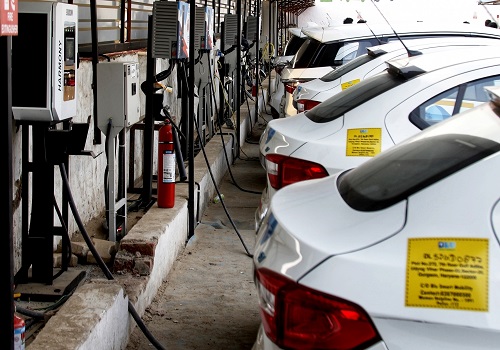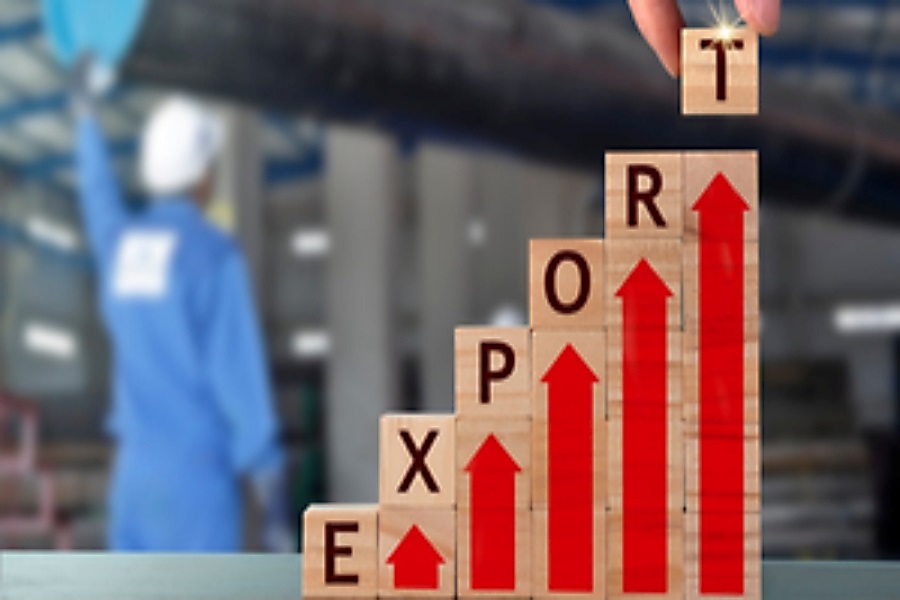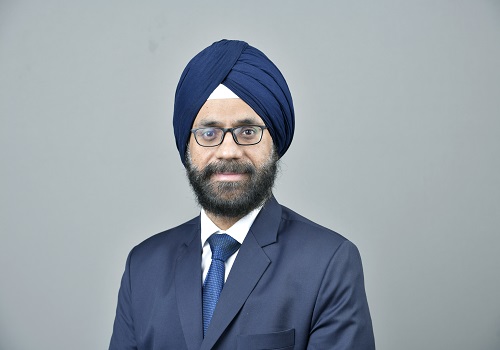Gold trading range for the day is 70190-72090 - Kedia Advisory

Gold
Gold prices experienced a modest increase of 0.23%, closing at 71,214, propelled by a stronger-than-anticipated inflation report for the first quarter. This outcome reinforced expectations of a delay in the Federal Reserve's easing cycle initiation. The GDP data revealed a 1.6% annualized growth rate in the last quarter, surpassing forecasts. Additionally, the core personal consumption expenditures (PCE) price index surged by 3.7% in the first quarter, exceeding expectations of a 3.4% rise. Following the GDP report, the U.S. rate futures market adjusted its expectations, with the probability of a rate cut in September decreasing to 56.7%, down from 70% previously. Meanwhile, China witnessed a notable increase in net gold imports via Hong Kong, soaring by 40% in March compared to February. China's central bank also bolstered its gold reserves by 160,000 troy ounces in March, contributing to the nation's robust gold holdings. Technically, the gold market observed fresh buying activity, evidenced by a 0.29% increase in open interest, settling at 19,417 contracts. Currently, gold finds support at 70,700, with potential downside testing at 70,190. Conversely, resistance is anticipated at 71,650, with a breakout potentially leading to further testing at 72,090. Overall, gold's performance reflects its status as a safe-haven asset amidst economic uncertainties and inflationary pressures. Investors are closely monitoring inflation data and Fed policy signals for insights into future monetary policy decisions.
Trading Ideas:
* Gold trading range for the day is 70190-72090.
* Gold steadied after a hotter-than-expected US inflation reading for the first quarter
* Data showed that GDP increased at a 1.6% annualized rate in the last quarter
* The U.S. rate futures market has priced in a 56.7% chance of a rate cut in September, down from 70%
Silver
Silver prices edged up by 0.23% to settle at 80684 amid a backdrop of rising U.S. Treasury yields, fueled by lingering concerns over persistent inflation. The latest economic data indicated a slowdown in U.S. economic growth for the first quarter, but an uptick in inflationary pressures suggested that the Federal Reserve might delay interest rate cuts until September. Despite the tempered economic growth, positive indicators in the labor market were observed, with weekly jobless claims coming in lower than expectations, signaling continued strength in the employment sector. Looking ahead, the Silver Institute industry association forecasts a 17% increase in the global silver deficit to 215.3 million troy ounces in 2024. This projection is attributed to a 2% growth in demand driven by robust industrial consumption, coupled with a 1% decline in total supply. Silver's diverse applications in jewelry, electronics, electric vehicles, solar panels, and investment purposes underpin its sustained demand amidst a structural market deficit entering its fourth consecutive year. From a technical standpoint, the market witnessed short covering, evidenced by a drop in open interest by -22.25% to settle at 12,700 contracts. Silver currently finds support at 79885, with potential downside testing at 79080. Conversely, resistance is anticipated at 81310, with a breakthrough possibly leading to further testing at 81930. Overall, silver's price performance reflects investor sentiment influenced by inflationary concerns and expectations regarding Federal Reserve policy. Investors are closely monitoring economic indicators and central bank actions for insights into future silver price movements and trading opportunities.
Trading Ideas:
* Silver trading range for the day is 79080-81930.
* Silver prices stabilizes after economic data showed signs of persistent inflation.
* US economic growth slows in first quarter; inflation surges
* US Treasury yields hit over five-month highs
Crude oil
Oil prices edged up by 0.32% to settle at 6911, buoyed by an optimistic demand outlook and ongoing supply risks linked to the Middle East conflict. Despite a slowdown in U.S. economic growth in the first quarter, rising inflation indicated that the Federal Reserve might delay interest rate cuts until September. However, concerns arose as U.S. gasoline stockpiles fell less than expected, while distillate stockpiles rose contrary to forecasts, signaling potential demand slowdown. Unexpectedly, U.S. crude inventories sharply declined last week, accompanied by increased exports. This occurred amidst apprehensions about cooling U.S. business activity and the Fed's potential delay in rate cuts due to robust inflation and employment data. Meanwhile, the conflict between Israel and Hamas in the Gaza Strip threatened to escalate, potentially disrupting oil supplies. However, direct conflict between Israel and Iran, a key oil producer, has not materialized since last week. Technically, the market observed short covering, with a decrease in open interest by -1.58% to settle at 5242 contracts. Crudeoil is currently finding support at 6854, with potential downside testing at 6796. Conversely, resistance is expected at 6958, with a breakthrough possibly leading to further testing at 7004. Overall, oil prices remained resilient, driven by a combination of demand optimism, supply risks, and geopolitical tensions. Market participants are monitoring these factors closely for potential impacts on price movements and trading opportunities.
Trading Ideas:
* Crudeoil trading range for the day is 6796-7004.
* Crude oil recovers underpinned by an improving demand outlook and persistent supply risks related to the Middle East conflict.
* U.S. economic growth slowed in first quarter
* U.S. gasoline stockpiles fall less than expected
Natural gas
Natural gas prices experienced a decline of -1.61%, settling at 165.3, driven by expectations of reduced heating demand in the upcoming week. LSEG reported a decrease in gas output in the Lower 48 U.S. states for April compared to March, reflecting a broader trend of declining production. Despite this, hopes of a potential resurgence in gas processing emerged as the first tanker departed from Freeport LNG's Texas export terminal, following an outage earlier in the month. The decline in U.S. gas production in 2024, attributed to energy firms delaying well completions and reducing drilling activities amidst low prices, has impacted the market dynamics. Notably, EQT and Chesapeake Energy, two major players in the industry, have adjusted their operations in response to market conditions. US utilities added a significant 92 billion cubic feet (bcf) of gas into storage during the week ended April 19th, exceeding market expectations and contributing to a surplus compared to previous years and the five-year average. Technically, the market witnessed fresh selling, with open interest rising by 15.67% to settle at 36,937 contracts. Natural gas is currently finding support at 162.4, with potential downside testing at 159.4. Conversely, resistance is anticipated at 167.6, with a breakthrough possibly leading to further testing at 169.8. Overall, the performance of natural gas prices reflects a delicate balance between supply dynamics, demand outlook, and storage levels. Investors are closely monitoring production trends, storage data, and weather forecasts to gauge market direction and trading opportunities in the natural gas sector
Trading Ideas:
* Naturalgas trading range for the day is 159.4-169.8.
* Natural gas slipped on an outlook for reduced heating demand next week
* US utilities added 92 bcf of gas into storage during the week ended April 19th 2024, the biggest rise in six months
* Natural gas output in Lower 48 U.S. states fell to an average of 96.8 bcfd in April from 100.8 bcfd in March.
Copper
Copper exhibited a notable uptick of 0.8%, settling at 852.85, buoyed by sustained investment fund inflows and optimistic forecasts signaling a potential deficit in the refined copper market this year. Goldman Sachs projects a deficit of 428,000 tons in 2024, with expectations of London copper prices reaching $12,000 per ton within the next 12 months. However, in China, the Yangshan premium hit zero for the first time on record, indicating subdued appetite for copper imports amidst elevated prices. Chilean President Gabriel Boric anticipates gradual production growth at state-run miner Codelco, targeting 1.7 million tons by 2030, amid bullish sentiments on copper price appreciation. Trafigura forecasts robust additional copper consumption, driven by flourishing activity in electric vehicles, power infrastructure, AI, and automation sectors, expecting a surge of at least 10 million metric tons over the next decade. Moreover, recent data reveals China's robust copper cathode output, exceeding expectations with a year-on-year increase of 5.06% and total output from January to March growing by 7.64% year-on-year to 2.9196 million metric tons. Technically, the copper market witnessed fresh buying momentum, with open interest rising by 8.19% to settle at 5,511 contracts. Presently, copper finds support at 845.4, with potential downside testing at 838, while resistance is anticipated at 858.6, with a potential breakout leading to further testing at 864.4. In summary, copper's price performance reflects ongoing bullish sentiments fueled by investment inflows, forecasts of supply deficits, and robust demand projections from key sectors.
Trading Ideas:
* Copper trading range for the day is 838-864.4.
* Copper prices gains due to investment fund inflow and forecasted market deficit.
* Goldman Sachs predicts global refined copper market deficit of 428,000 tons in 2024.
* Yangshan premium drops to zero in China, indicating weak copper import appetite.
Zinc
Zinc prices surged by 1.92% to settle at 252.35, driven by fund buying and concerns surrounding supply dynamics. China's refined zinc production witnessed a notable increase, contributing to worries about potential supply shortages in the market. Despite a rise in production, positive signals emerged from China's factory activity, which expanded at the fastest pace in over a year, indicating robust demand in the world's largest zinc consumer. Similarly, encouraging reports from the US manufacturing sector and Germany's industrial output further buoyed market sentiment. Research agency BMI anticipates continued growth in refined zinc production in 2024, following a rebound from the deficits seen in previous years. However, despite expectations of an annual surplus, factors such as the resumption of Glencore’s Nordenham smelter in Germany and the completion of Norway’s Odda mine expansion are poised to bolster global zinc production. On the demand side, global zinc consumption is forecasted to increase by 2.6% in 2024, albeit overshadowed by sluggish growth in the world economy. From a technical perspective, the market observed fresh buying momentum, with open interest rising by 18.27% to settle at 3,865 contracts. Zinc is currently finding support at 247.6, with potential downside testing at 242.7. Conversely, resistance is anticipated at 256.4, with a breakthrough possibly leading to further testing at 260.3. In summary, zinc prices surged amid investor optimism fueled by supply concerns and strong demand indicators from key global markets.
Trading Ideas:
* Zinc trading range for the day is 242.7-260.3.
* Zinc prices gained amid worries about supply
* Research agency BMI, said refined zinc production growth will continue to rebound in 2024.
* The anticipated resumption of Glencore’s Nordenham smelter and Norway’s Odda mine expansion later in the year is set to bolster global zinc production.
Aluminium
Aluminium prices experienced a slight decline of -0.59%, settling at 235.4, driven by profit booking following earlier gains fueled by supply concerns amid sanctions on Russian metals. Washington and London's moves to restrict the acceptance of Russia-made aluminium by exchanges further impacted market dynamics. LME data revealed ongoing investor notifications to withdraw metal from warehouses, reducing available LME aluminium stocks to 171,200 tonnes, the lowest level since August 2022. China, the world's largest importer and producer of aluminium, recorded a significant uptick in imports of unwrought aluminium and products, surging by 89.8% in March and totaling 1.1 million tons in the first quarter, reflecting robust demand despite elevated prices. Additionally, China's primary aluminium output expanded by 7.4% in March, reaching 3.59 million metric tons, driven by increased demand across various sectors including automotive, construction, and packaging. China's manufacturing activity also showed signs of recovery, expanding for the first time in six months, further supporting aluminium demand. Technically, the aluminium market observed fresh selling pressure, with open interest rising by 2.05% to settle at 3,880 contracts. Presently, aluminium finds support at 233.4, with potential downside testing at 231.4, while resistance is anticipated at 238.2, with a potential breakout leading to further testing at 241. Ongoing geopolitical developments and technical factors will continue to influence price movements in the aluminium market.
Trading Ideas:
* Aluminium trading range for the day is 231.4-241.
* Aluminium dropped on profit booking after prices gained on supply concerns.
* LME aluminium stocks reduced to 171,200 tonnes, representing the weakest level since August 2022.
* China's March aluminium imports jump 90% on – year
Cotton candy
Cottoncandy prices experienced a marginal decline of -0.07% to settle at 58620, driven by weakening demand and a growing world carryover. Despite a notable increase in net sales reported in the USDA weekly export sales report, upside potential was limited due to expectations of improved crop yields in countries such as Australia. However, the International Cotton Advisory Committee (ICAC) projected increases in cotton-producing areas, production, consumption, and trade for the upcoming season, 2024-25, indicating a potential shift in market dynamics. India, the world's second-largest cotton producer, is expected to witness a significant decline in cotton stocks in the current marketing year, reaching their lowest level in more than three decades. Lower stockpiles are anticipated to constrain exports and support global prices while potentially lifting domestic prices and impacting the margins of local textile companies. India's cotton production is forecasted to decrease slightly in the upcoming season due to farmers shifting acreage to higher-return crops, but mill consumption is expected to rise as yarn and textile demand improves in major international markets. In China, cotton imports are forecasted to increase for the upcoming marketing year, driven by higher domestic and international demand for textile and apparel products. Despite a decline in production in other regions, stable planted areas in Xinjiang are expected to maintain production levels. Technically, the market witnessed fresh selling pressure, with open interest increasing by 0.97% to settle at 416 contracts. Cottoncandy is currently finding support at 58400, with potential downside testing at 58170. Conversely, resistance is anticipated at 58860, with a breakthrough possibly leading to further testing at 59090.
Trading Ideas:
* Cottoncandy trading range for the day is 58170-59090.
* Cotton dropped amid declining demand, and a growing world carryover.
* India's cotton stocks set to plunge 31% y/y to lowest in decades
* Cotton stocks at the end of 2023/24 marketing year could fall to 2 million bales - CAI
* In , a major spot market, the price ended at Rupees dropped by percent.
Turmeric
Turmeric prices experienced a decline of -1.57%, settling at 19,082, driven by expectations of new arrivals from the Marathwada region in Maharashtra. However, the downside was limited due to below-normal supplies and active festive demand. New crop arrivals were reported in key markets like Nanded, Nizamabad, and Erode, with quantities significantly higher compared to the previous week. Despite the anticipation of increased supply, turmeric production for 2023-24 is estimated to be lower than the previous year, according to the Ministry of Agriculture and Farmers’ Welfare's first advance estimate. Demand destruction has also been observed as prices surged, leading to a shift towards hand-to-mouth purchases. However, regions like Sangli, Basmat, and Hingoli are witnessing good demand for quality turmeric on expectations of an increase in sowing area this year. In terms of trade, turmeric exports during April-February 2024 witnessed a slight decline, while imports decreased notably during the same period. However, there was a rise in both exports and imports in February 2024 compared to the previous month, indicating fluctuations in trade dynamics. Technically, the turmeric market observed fresh selling pressure, with open interest increasing slightly by 0.21% to settle at 18,850 contracts. Presently, turmeric finds support at 18,364, with potential downside testing at 17,648, while resistance is anticipated at 19,656, with a potential breakout leading to further testing at 20,232. In conclusion, Fluctuations in trade volumes and technical indicators will continue to influence market sentiment in the coming sessions.
Trading Ideas:
* Turmeric trading range for the day is 17648-20232.
* Turmeric dropped as new arrivals are expected from the Marathwada region in Maharashtra.
* However, downside seen limited amid below normal supplies and active festive demand.
* The Ministry of Agriculture first advance estimate for turmeric production in 2023-24 is estimated at 10.74 lakh tonnes
* In , a major spot market, the price ended at Rupees dropped by percent.
Jeera
Jeera prices experienced a slight decline of -0.4% to settle at 22665, primarily due to the anticipation of further increases in arrivals pressuring the market. However, downside movements were limited as global buyers continued to prefer Indian jeera amidst tightening global supplies. The market witnessed daily arrivals of 10000 to 12000 bags in the Rajkot Mandi, surpassing demand levels. New arrivals in Gujarat and Rajasthan contributed to the surplus, with increased sowing areas leading to record production levels. In Gujarat, the production of cumin is estimated to reach 4.08 lakh tonnes, a significant increase from the previous year's 2.15 lakh tonnes. Similarly, Rajasthan saw a 53% increase in cumin production, resulting in a doubling of overall production in major cumin-producing areas of India. Despite expectations of a substantial increase in cumin exports in 2024, exports during Apr-Feb 2024 dropped by 23.75% compared to the previous year, with Feb 2024 witnessing an 11.54% decline from Jan 2024. Technically, the market observed long liquidation, with a drop in open interest by -2.15% to settle at 2454 contracts. Jeera is currently finding support at 22440, with potential downside testing at 22200. Conversely, resistance is anticipated at 22940, with a breakthrough possibly leading to further testing at 23200. Overall, Jeera prices faced downward pressure amid expectations of increased arrivals and record production levels in major producing regions. While global demand for Indian jeera remains strong, the market is closely monitoring export trends and production forecasts for insights into future price movements and trading opportunities.
Trading Ideas:
* Jeera trading range for the day is 22200-23200.
* Jeera dropped as there is a possibility of further increase in arrivals pressure in the market.
* There will be a huge increase in cumin exports, which will reach about 14-15 thousand tonnes in February 2024.
* New arrivals have started in Gujarat since last 20-25 days and new arrivals have started in Rajasthan also since last 15 days.
* In Jodhpur, a major spot market, the price ended at 24500 Rupees dropped by 0 percent.
Views express by all participants are for information & academic purpose only. Kindly read disclaimer before referring below views. Click Here For Disclaimer



















